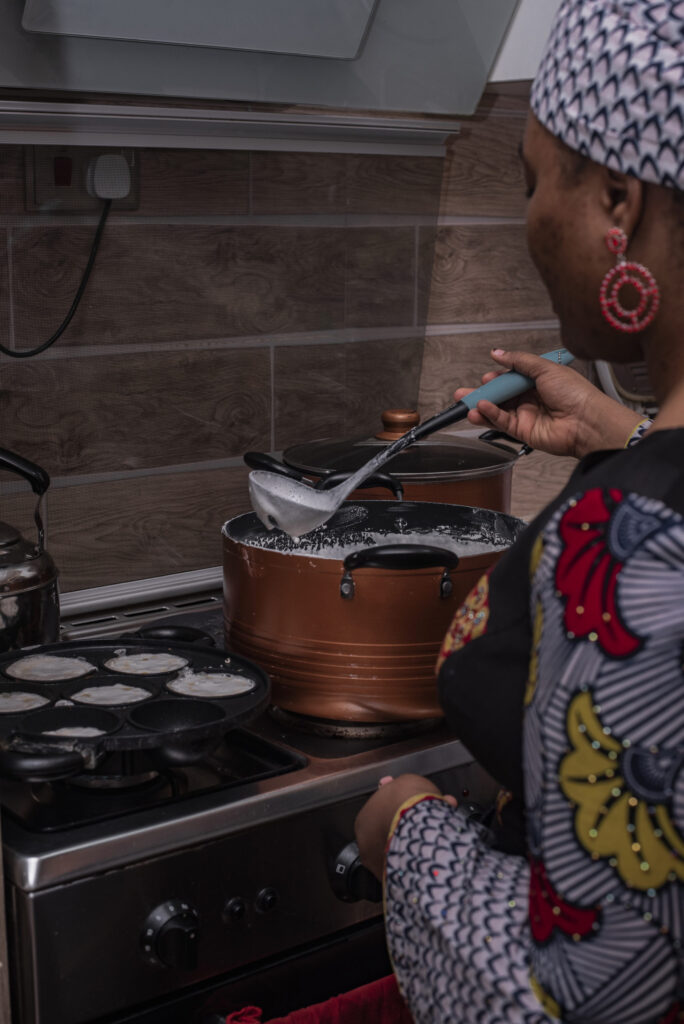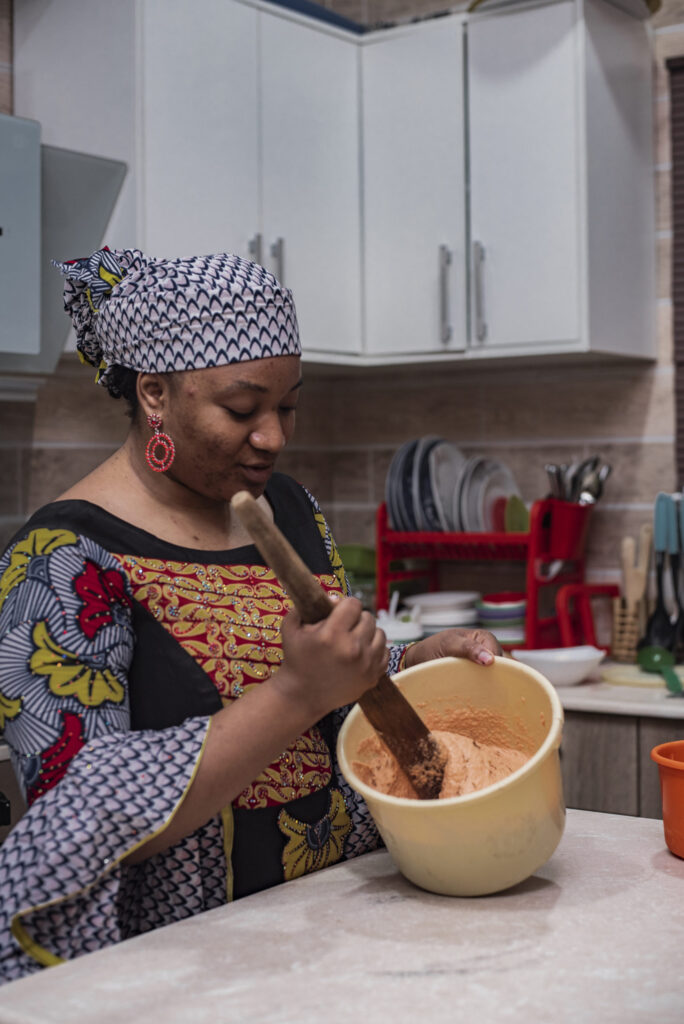Black Joy Through Food is a Sweet July series in collaboration with Black Women Photographers. This photo essay is by Alade Aderonke.
Having Sahur and Iftar with family and friends during the holy month of Ramadan is an unspoken custom. Sahur and Iftar are the names of the two meals eaten by Muslims throughout Ramadan. Sahur is meant to be consumed before sunrise. After that, no food or water is allowed to enter the lips of the fasting person. Iftar is the meal served after sunset to break the fast.
Nazira is a mother of two, who prefers to have the majority of the base of all of her foods for Ramadan prepared and preserved in the freezer. Below, we follow along as she prepares each meal for her family’s Ramadan tradition.
Nazira adds yeast to the Masa paste and uses her hands to even it out, leaving no lumps in her kitchen at her home in Kubwa, Abuja, Nigeria.
“Do you know why sugar is an important ingredient in Masa?” asks Nazira. “The color of Masa, when fried, comes from the sugar added to the paste. You should be a sugar lover if you want a really brown Masa.” She also sprinkles some salt on top.
Nazira scoops out the Masa with a ladle spoon and places it into a heated Masa pan containing groundnut oil. She explains that there are two ways to fry Masa: with the Masa-pan or with a regular frying pan. She prefers to use the Masa pan because it provides the shape and texture that her Masa requires.
Here’s the Masa served in a thermos flask at Iftar. It comes out just like a pancake when it is ready.
Nazira stirs Masa sauce while cooking on the gas. She learned how to make her Masa sauce from her mum. She blends tomatoes, scotch bonnet and onion into paste, heats up oil, pours it in and lets it fry until it is a bit dry. She then adds seasoning, beef, boiled egg, and spinach—leaves it to steam for five minutes and removes it from the pan.
Nazira stirs Pap paste for Iftar. Pap is made from Maize, Dawa (Guinea Corn), Gero (Millet), Cloves and Ginger. The combination is soaked for a day for softness, then grinded until it is smooth. After grinding, she sieves out the chaff from the mixture, separates the water from the paste by allowing it to settle and places the resulting mixture in a special bag to extract even more water. The paste is then stored in a refrigerator.
Nazira dishes a Pap into a bowl for Iftar. When you are ready to make the Pap, take it out of the refrigerator and scoop the desired amount, depending on how many people you are preparing for. Dilute the paste with warm water to smoothen it out and make a fine mixture without any lumps. Add boiled water slowly to the mixture and whisk gently. If it doesn’t get thick, you can apply some heat from the gas to dry out excess water.
Nazira stirs Moi Moi paste after adding seasoning in warm water. Moi Moi, usually eaten with Pap, is made out of peeled beans. “I like to soak my beans in water for some time before washing off the skin; some people prefer to wash theirs immediately,” says Nazira. Scotch bonnet, onions, garlic and ginger are added to the washed beans before the mixture is taken to the machine for grinding.
Nazira serves a spread of food consisting of Masa and Masa Sauce, Moi Moi and Pap, Fruit Salad, and Dates on the dining table.
Nazira and her family have Iftar in her dining room at her home in Kubwa, Abuja, Nigeria.
Masa Sauce
Ata Rodo (Scotch Bonnet)
Tomato
Tatashe (Bell Pepper)
Onion
1 Egg
Biscuit Bone
Beef
Seasoning
Masa
White Rice
1 Onion
Yeast
Baking Powder
Warm Water for soaking
Salt
Pap
Maize
Dawa (Guinea Corn)
Gero (Millet)
Cloves
Ginger
Moi Moi
Beans
Red Pepper
Onion
Garlic
Ginger
Groundnut Oil
Crayfish/Egg/Deboned Boiled Fish/Chicken
Nylon/Leaf

















